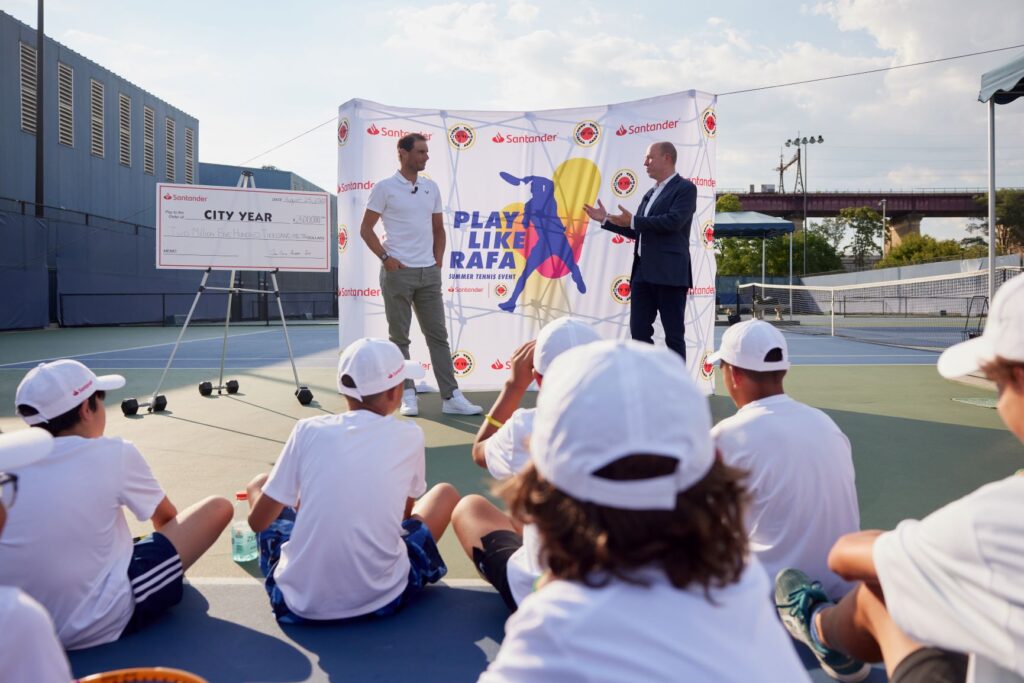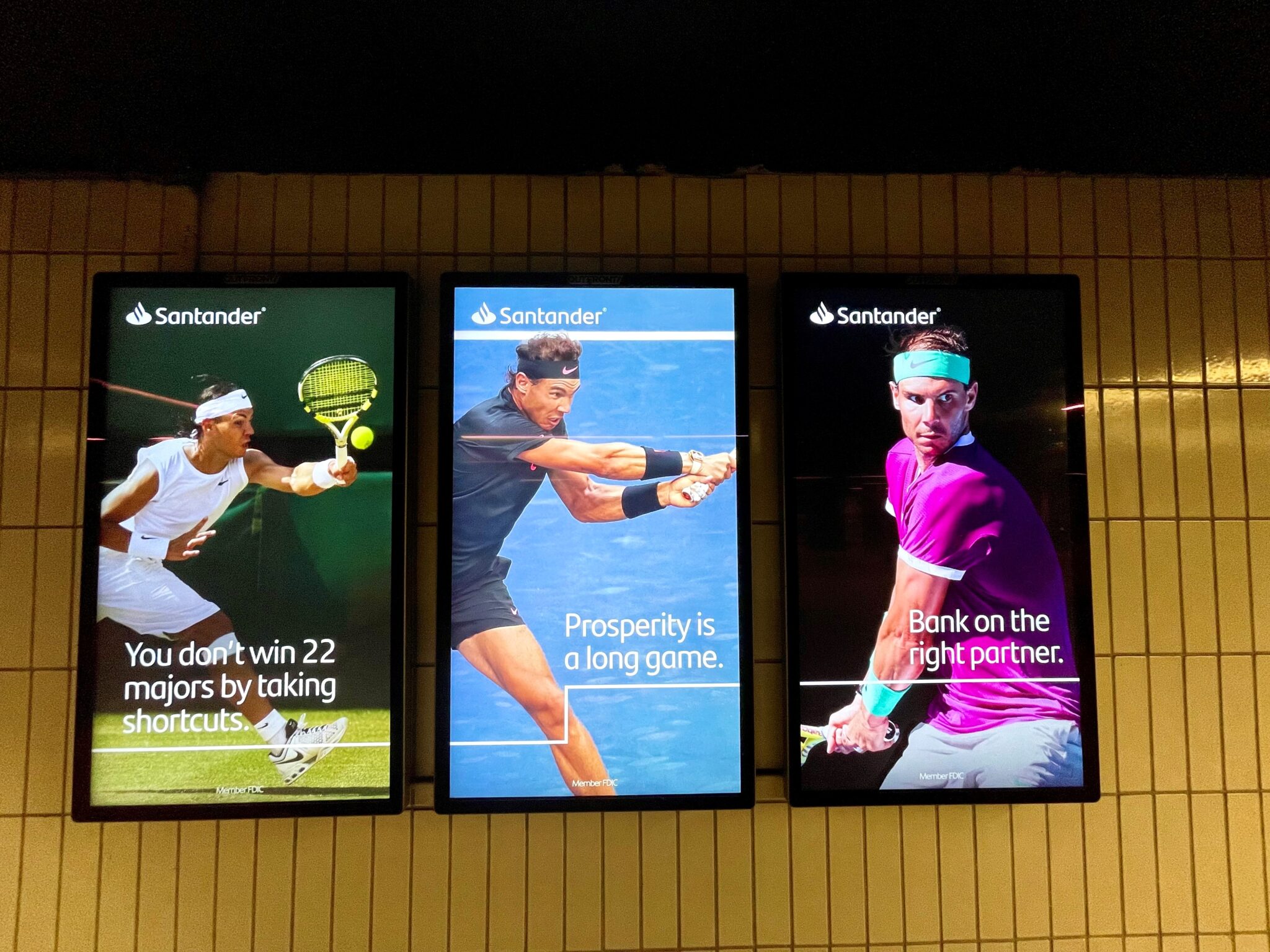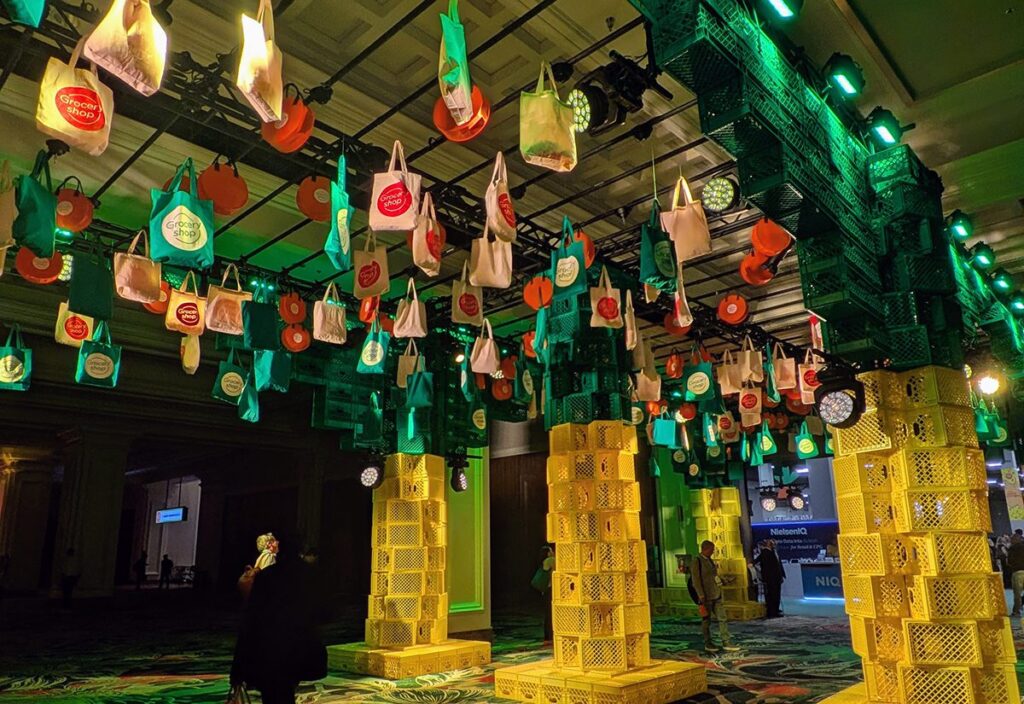Officially sponsoring a major global sports event can be pricey. The just-wrapped US Open tennis tournament, for instance, rakes in millions of dollars from sponsors—which included Cadillac, American Express and Chase Bank this year—seeking to secure a presence inside the stadium.
But there are other ways to get your marketing messages in front of consumers through more unofficial channels. Take Santander Bank, the global sponsor of Spanish tennis champion Rafael Nadal, which leveraged the athlete’s presence at the Open with a brand awareness campaign featuring a TV spot he starred in, out-of-home advertising along attendee walkways and a cause marketing partnership with nonprofit City Year that included a coaching session with Nadal himself.
“We’re not spending the amount of money that probably some of the larger banks would do by being an official sponsor of the US Open,” Maha Madain, Chief Marketing Officer at Santander Bank, told Chief Marketer. “So how do we create a lot of awareness in a very strategic and economical way? Not being in the heart of the stadium, but surrounding the stadium.”
We spoke with Madain about the campaign’s strategic marketing goals, expansion plans for the future, the importance of leveraging partnerships and the challenges financial marketers face, particularly from a regional perspective.
Chief Marketer: What is the inspiration behind the campaign with Rafael Nadal?
Maha Madain, Chief Marketing Officer at Santander Bank: Globally, we are official sponsors of Rafa Nadal. Santander Bank is a globally known brand, more in Spain and South America. In the U.S., we’re relatively new and concentrated in the Northeast as well as Miami. The inspiration from a brand strategy perspective was, how do we create brand awareness by leveraging partnerships that represent our core values?
Rafa is known for his grit, perseverance, determination, commitment to the game and being in the business for 20 years, with all the ups and downs. Yet he’s committed and he’s there. That’s parallel to our core values, [which] are all about helping people and businesses prosper in a sustainable way. Our brand strategy, and this campaign in particular, is about how we create that relevant awareness in the minds of our audiences through these kinds of partnerships—where you meet them, where they’re interested, at moments that matter to them. In this case, it’s the US Open.
CM: Your campaign also has a live event component. How have you used Rafa for that?
MM: Rafa has appeared on social media talking about us and so forth, but this is our first time doing this in the U.S. He attended an event that we held with nonprofit City Year, whom we’ve supported for years. He gave us an hour of his time where he played tennis with young kids and coached them on how to manage life expectations and how to not let defeat hold you back. In our spot we demonstrate that we’re here for the long game, which is obviously what he’s here for, and how you need the right partner to help you achieve your goals.
CM: What KPIs are you tracking?
MM: We’re trying to lift brand awareness. As I mentioned, Bank Santander has strong brand awareness globally, but we don’t in the U.S. The name Santander in the U.S. started in 2013, so we’re relatively young, but we have plans for national expansion as well as digital transformation. We’ve announced a multi-year investment in digital transformation centered around the customer experience. COVID has taught all of us how important digital is. We’re going through a transformation of how we do business and relying more and more on social media and digital marketing to be efficient and to drive our messages.
CM: Why did you choose a commercial and out-of-home as marketing tactics for the campaign?
MM: We’re not spending that amount of money that probably some of the larger banks would do by being an official sponsor of the US Open. So how do we create a lot of awareness in a very strategic and economical way? Not being in the heart of the stadium, but surrounding the stadium. How do we do it with the right budget? As you know, there were very big names within the stadium. So how do we strategically create that awareness? That’s what led us to this out-of-home campaign, where we had significant billboards in the boardwalk leading up to the stadium that you couldn’t miss. We did takeovers of the subway station, outdoor materials and digital to display that message. If we couldn’t be inside, how could we surround it? We also leveraged a lot of our branches in the area with digital messaging on our ATM screens.
CM: What are some of the biggest challenges that you face right now as a financial marketer? And how are you meeting those?
MM: There are a couple of things. From a marketing perspective, how do I create brand awareness when all of this change is happening? You are rolling out new products and trying to address a lot of the activities that are occurring, but how do I create awareness within a certain budget? As a regional bank, we’re trying to build that momentum. That’s one of the challenges, and this campaign is a prime example of how we’ve addressed some of it.
The other challenges we’re dealing with is how do you transform your capabilities so that you are ready and prepared? I think all banks are working through that. We’ve learned through COVID that consumers yearn for doing business in the most friction-less way. They want be able to access their accounts in the easiest way. So we’re very focused on building our customer experience—not only from the physical channel, of course, which we do a very good job of—but also, how do we do it digitally, in a human way? How do you build those journeys to deliver that digital experience so that consumers feel at ease in doing it?
CM: What is your growth strategy for the brand?
MM: We touched on it a little bit, but it’s around how we leverage partnerships that make sense and reach audiences. One of the next partnerships we’re looking at is Formula One. That is a long-term partnership for Santander Global, at Formula One and Ferrari. We’re working with them on how we create awareness of our focus on sustainability as an organization. We’re looking for opportunities like that to showcase these core values: commitment to consumers and businesses, being here for the long-term, sustainability, equality in the marketplace. These are all pillars that we will be focusing on in the next 12 to 18 months to advance the brand message forward until we’re national and able to leverage a strong national brand positioning.
CM: What are the key trends that marketers should be paying attention to right now?
MM: To be a successful CMO, you have to be open to embracing new trends and changes. You have to embrace new mediums, things that are coming up, and see how they evolve. I also think it’s about being very data-driven. In everything we do, that’s the biggest pillar. Unless you’re part of a very large organization that spends a ton of money on marketing, how do you become very smart and surgically invest your budget—because you are the investor of that budget—in the most efficient way? The only way to do that is by being very data-driven.
My advice would be, look at how you can reach your target audience in the most effective and efficient way, and leverage great opportunities. You don’t have to be the biggest spender, but leverage what you have for how you can win in that space. And if you think that way, you could advance quickly.






